Are you trying to generate B2B leads through social media?
Identifying quality prospects is tough regardless of the industry you’re in, but it’s proven to be particularly challenging for B2B companies in general due to the reduced market size.
Creating strategies where you consistently acquire quality B2B prospects that eventually turn into leads requires deep knowledge of your audience, the industry, and your products. Luckily, you now have a wide variety of channels through which you can reach potential customers. Social media platforms are a great example as they collect user information and make it available to companies looking for new ways to connect with their audiences.
Although many B2B businesses struggle to find a good rhythm on this platform, LinkedIn has become one of the best places for business-to-business companies to generate quality leads. Let’s explore the idea of generating leads on LinkedIn and give you a few tips to attract quality prospects through this social platform.
Today, I’m going to introduce you to the sleeping giant of LinkedIn — qualified lead generation. But, before you jump into generating leads you might want to look into some of these details.
- Key steps to take to build a marketing plan
- Marketing budget template checklist
- Basic checklist for brand design
- Using customer segmentation for building buyer personas
- Increasing revenue by improving your sales funnels
The Importance of Focusing on LinkedIn Lead Generation
Before going fully into LinkedIn lead generation, it’s worth highlighting the importance of seeking quality prospects. In simple terms, leads are potential customers that enter your sales pipeline and will, hopefully, become paying clients in the future.
Lead generation is the practice of identifying, attracting, and vetting prospects in order to determine who has a higher chance of becoming a customer. This practice is important because it allows you to build your sales funnel and grow your business in a predictable way, giving you the ability to make adjustments to improve the performance of your business.
In the B2B context, lead generation is more challenging due to the reduced size of the market. For a B2C business that sells clothing, the size of its potential audience is huge – anyone can fit the bill pretty much. However, if a B2B business sells computer repair goods, their target audience is significantly smaller due to the restriction in market size, not to mention the competition, market fluctuations, and other factors that often affect lead generation.

Before going any further, it’s worth noting that not all leads are the same. Logic may tell you that more leads are better because they increase your chances of closing a deal. But, it’s important not to get carried away by the quantity and focus on the quality of the prospects you’re generating.
Remember that each lead represents an investment, so it’s much better to have 5 quality leads that will likely convert than to have 25 inferior prospects that have a low chance of becoming customers.
Qualifying B2B Leads
As the name suggests, the lead qualification process is used to determine how likely prospects are to become customers. This process is unique to each industry, and it can even vary from one business to another.
One of the main challenges in the lead qualification process is the fact that the sales and marketing departments usually have different definitions of a qualified lead. This results in the old paradox where the marketing team blames sales for not doing enough with the leads, and the sales department claims that the leads they are getting are not good quality.
While this was acceptable in the past, modern companies are constantly towards integrating these two departments in order to assure smooth sailing. So, how can you qualify your B2B prospects in a way that is suitable for both your sales and marketing teams?
Both departments agree that a prospect is transformed into a lead when he/she enters the sales funnel via a specific action, like filling out a form. Now, that lead must complete at least one more action or reach a specific milestone to become qualified.
In order to set up qualified lead milestones that work for both the sales and marketing teams, you can try approaches like:
Lead Scoring
Lead scoring is a technique that requires the development of a unique number-based ranking system, which can vary significantly from one company to another. This approach helps you classify prospects based on a scoring system and determine how likely they are to become customers depending on the grade they get. This can be a value in a 1 to 10 scale, a “temperature” code based on hot and cold, or any other grading system you want to implement.
Buyer Persona Creation and Matching
The process of creating a buyer persona is somewhat similar to lead scoring, but without the math element. Instead, you create a specific description of your perfect customer, which can include the industry, job title, approximate revenue, and other characteristics that your conversions have in common. If your lead is close enough to the buyer persona, you’ve got yourself a qualified lead.
Analyzing User Actions
Some companies have kept it simple and qualify prospects based on the actions they take. For instance, filling out a form, reaching out for a quote, or requesting a free demo can all transform a prospect into a qualified lead because these actions indicate his or her interest in the product.
Identifying the Best Place to Get B2B Leads
Now that we’ve covered the importance of lead generation and qualifying potential customers, it’s time to learn how to attract quality prospects. As we mentioned before, there are dozens of channels and techniques that B2B companies can use to attract to-be customers, albeit some are much more effective than others.
These include, but are not limited to:
Webinars and Gated Content
Webinars are informative and often provide practical information, making them a great way to attract potential prospects and generate leads. After figuring out what your webinar will encompass, you can craft the content and ask potential clients, to provide contact information in exchange for access. The best part? Webinars can be combined with other channels on this list in order to amplify their reach.
Gating content, which is the practice of limiting access to assets on your site until you receive contact information from potential clients, is becoming another common approach. As long as the content is valuable enough, prospects will be happy to relinquish their contact details in return. Great examples of gated content include white papers, industry reports, and ebooks.
Video Content and Email Marketing
Unlike webinars, videos don’t always have to transmit practical information. That said, this approach must include sound marketing elements in the sense that you have to include a CTA that tells viewers what you want them to do.
A staple for marketers and companies around the world, email marketing usually provides better results if you avoid blasting and create an ultra-targeted campaign instead. For this to work, you have to get creative in how you lure a visitor into giving you his or her email address.
Drip email campaigns may take time and require large volumes to produce significant results, but can still be an effective way to generate leads.
Website Forms
Contact forms and similar elements found on websites are another common direct approach. Simply ask visitors to fill out the form and request more information, which is usually followed up by contact from the sales team.
PPC Ads
PPC ads on search engines can be extremely effective in some B2B industries, but campaigns need to be crafted to perfection. If this is the digital marketing technique you like the most, working with a marketing agency that specializes in pay-per-click (PPC) advertising can exponentially improve your results.
Referrals, Direct Mail, and Lead Databases
These three approaches are known well-known because they are among the oldest forms of marketing, but they are fundamentally different.
Referrals are quality prospects generated from happy customers’ recommendations. These prospects have a high conversion rate and are usually pleased to go through the motions because they are referred by someone they trust.
Direct mail seems like a millenary practice at this stage of the game, but it can still work with certain industries and markets. Just not B2B, necessarily.
Purchasing lead databases also seems like an ancient approach because the information is often outdated, leaving very little to be salvaged. Not to mention the fact that most leads didn’t voluntarily opt-in, which can drive dissatisfaction through the roof.
B2B Social Media
And finally, the holy grail of modern B2B lead generation. Social media channels allow you to reach your audience through paid and organic means while giving you an ocean of information about your targets.
LinkedIn has become the go-to social media platform for B2B leads generation because it revolves around businesses and has attracted a global audience that consists of hundreds of millions of professionals.
Why is LinkedIn a Good Source of Leads?
According to research conducted by Hubspot, the average conversion rate for B2B companies on Google Ads is about 2.5%. The global conversion rate for LinkedIn ads, on the other hand, is closer to 9%, surpassing Google’s efficiency rate by more than 300 percent.
But, this isn’t the only reason why B2B companies should try to generate leads from LinkedIn.
According to LinkedIn estimates, about 80% of members on this social platform have the power to drive or influence business decisions.
From top-suite executives to managers and other decision-makers, you can use the targeting features on LinkedIn to attract users that are responsible for finding solutions within a business. You can adjust your ads and show them based on users’ employer, role, industry, seniority level, and much more.
Furthermore, LinkedIn leads generation arsenal also includes Matched Audiences, which is a custom option that you can use to create retargeting campaigns, expand your reach, and tailor your campaign for the best results.
Acquisitional Power and Education
According to Salesforce, audiences on LinkedIn have more value than on other platforms because of both education and acquisitional power. It’s estimated that LinkedIn members are 93% more likely to have a college degree than the average user. This means that B2B companies can create complex ads that truly showcase the value of their services without
Not only this, but LinkedIn users also have twice as much acquisitional power when compared to the average person browsing the internet. While individual acquisitional power may be of little interest to B2B companies, knowing that users have a lot of disposable income means that you don’t have to worry about slashing prices or offering deals – simply prove your business’ value and your audience will be happy to learn more.
Ad Formats
Like many other social media platforms, LinkedIn has a variety of ad formats to choose from. You can create sponsored content that appears in the news feed across mobile and desktop devices. Companies can also opt to send ads to users via messages through Sponsored InMail, which can be tailored to drive more conversions and better engagement. Finally, you can target desktop users (which tend to have better conversion rates) through PPC Text Ads, which have a simple headline, description, and a small image next to the written elements.
Efficient Lead Generation Forms
LinkedIn Lead Gen Forms have earned a solid reputation among B2B marketers because they bypass one of the biggest challenges with traditional forms, which is to have prospects manually fill out each field. Instead of requesting users to provide information LinkedIn’s lead generation forms are pre-filled for each prospect, creating a seamless experience for users who want to find out more information.
Higher ROI
The ROI for LinkedIn ads can be as much as 3 times higher than other well-known online marketing platforms. It’s worth noting that the cost-per-click for LinkedIn ads is higher than Google search. However, because the conversion rate of these ads is also significantly higher, the cost per lead is reduced and ROI increases exponentially.
Measuring ROI is simple thanks to LinkedIn’s conversion tracking feature. This integrated tracker allows you to see which website visitors come from your LinkedIn ads, so you can use the analytic information to make improvements to your campaign.
How to Get the Most B2B Leads Out of LinkedIn
When it comes to B2B lead generation LinkedIn has become one of the top platforms to attract quality prospects. But, it’s important to take a structured approach and design a strategy that maximizes your investment.
Set Your Objectives
Like with any other marketing campaign, the first step to finding leads on LinkedIn is to set your objective. Getting sales is always the main goal, but you should set up different objectives that work as milestones that ensure you’re heading in the right direction.
Acquiring a certain number of qualified leads within a period of time is a good example of a tangible goal, but think about other objectives that are unique to your target audience’s decision-making process.
There’s no question that LinkedIn is a great place to get qualified leads, but you have to determine the specific approach you’ll use.
Will you use all the ad formats or only some of them? Will your ads redirect to your services pages or will you take a softer approach? Are you going to use forms to collect data? Where will the information be stored? You need to determine all of these and any other relevant details in your planning stages to avoid confusion later on.
Figure Out the Qualification Scheme
Once the approach has been defined, it’s time to move onto the qualification scheme. As with any lead generation campaign, you have to figure out when a prospect makes the leap to qualified lead status.
We’ve covered a few lead qualification techniques in this article, but remember that all companies and industries are unique. You may have to develop a unique formula or set of characteristics that help you identify leads that are ready to make a purchase.
Create B2B Lead Generation Campaigns
Now, you can move on to crafting your lead generation campaign. You may choose to drive as much traffic to your site as possible, use Lead Gen Forms to reel in qualified leads only, or launch a PPC campaign that sends prospects directly to a landing page that then collects information. Generally speaking, campaigns that incorporate a little bit of everything tend to yield the best results.
Keep in mind that your campaign needs to be optimized once you collect enough information. You can also choose to run a few variants from the beginning in order to try out different approaches and use this information early on in your campaign.
Finding a Reliable LinkedIn Lead Gen Form Expert
LinkedIn Lead Gen Forms are a great way to collect preliminary contact information from your prospects. That said, not every person that has a LinkedIn profile is willing to share this data right away, so you need to increase your chances of success by using the best setup.
By working with a LinkedIn Lead Gen Form expert, you’ll be able to improve conversions and enhance your lead generation efforts. Fannit helps B2B companies produce leads on LinkedIn by structuring Lead Gen Form templates in a way that showcases the benefits prospects get in exchange for information.
Below, we’ll detail the steps we take to improve your chances of success.
Create the Form Template
It’s important to understand that the lead generation forms on LinkedIn are designed to be convenient for both users and companies doing marketing on the platform. For people using LinkedIn for general business purposes, the field forms are already pre-filled in order to reduce the effort required on their behalf. Which, is especially convenient when on a mobile device.
The convenient design of the forms also goes beyond the pre-filled fields. They have an eye-catching, attractive CTA button, plus the form templates have been crafted so that they are user-friendly and intuitive even on smaller screens.
During the lead generation form creation process on LinkedIn campaign manager, our team puts together the offer headline, offer details, privacy policy URL that will go on each form. You can have up to seven fields on each form, but finding the right balance to help you attract more users.
It’s important to note that having too many fields on the forms may overwhelm your prospects and discourage them from submitting their request. Instead of going for the default value, we reduce the number of fields that potential prospects have to fill out, keeping it ideally between the 3 to 5 range.
We also determine if the information that’s requested is too sensitive. Users may not be willing to share some pieces of information, so we make sure that the data being collected is not sensitive or personal.
Offer Useful Content in Exchange for User Info
The success of your form will depend heavily on the incentives you make available to potential leads. Make sure that the content is valuable and that it comes in a form users can keep or always have access to, like an ebook, report, or webinar.
The key here is to create super-useful resources that give potential leads a taste of the value you’re offering.
Privacy and transparency have become crucial parts of all activity on the internet, especially marketing campaigns. Instead of a challenge, Fannit sees it as an opportunity to build a strong, trusting relationship with your potential leads. For this reason, we make sure that your privacy policy is visible somewhere on your forms.
Craft a Sponsored InMail or Sponsored Content Campaign
Sponsored InMail and Sponsored Content campaigns can be integrated with LinkedIn forms. But, these are presented in different ways. Sponsored Content lead gen forms are presented in users’ daily feed next to your ad. In Sponsored InMail ads, forms appear in the user’s inbox, allowing each individual member to fill the fields without much hassle.
As part of the form, we also include a thank you message that appears after the users submit their requests. If the lead gen form presented an incentive, we also consider crafting a custom landing page that includes a link to your content or that allows users to download the resource right then and there.
Find a CTA that Works
Having a CTA is essential, but you also have to ensure it produces the right results. Having an eye-catching button that uses active language and tells users what you want them to do can greatly improve the performance of each ad. Some examples of good CTA text include:
- Download Now
- Get Your eBook/Report/Resource
- Visit Our Website
- View eBook/Report/Resource Now
- Learn More
Advantages of LinkedIn Lead Generation Forms
If you’re trying lead generation on LinkedIn, you’ll quickly realize that its forms are one of the best tools at your disposal. This approach seamlessly combines convenience for both prospects and marketers, which results in an effective marketing channel that allows you to steadily grow your B2B business.
There are many advantages to running a LinkedIn form campaign. Some of these include:
Scalable Source of Quality Leads
LinkedIn is the most popular social media for professionals that want to network and find new opportunities. We’ve covered many of the reasons why the platform produces leads of remarkable quality in this article. But, the most impressive thing may be the fact that it can consistently generate a large number of prospects, making it a scalable way to build your company.
As with PPC platforms, a solid LinkedIn campaign allows you to generate profits according to your investment. LinkedIn generates such high-quality traffic that it can consistently and sustainably attract new prospects and run remarking campaigns for companies in most B2B industries.
Track Performance, ROI, and Other Key Metrics
The information you collect through LinkedIn forms can help you analyze the performance of your campaign and make adjustments to improve your results.
LinkedIn allows you to see metrics like lead form fill rate, the cost per lead at the campaign level, each lead’s job title, and the number of total leads generated. You can also breakdown your lead acquisition by professional audience segment and other demographic information.
Recommended Article: What’s the SEO ROI?
Ideal for Whitepapers, eBooks, Newsletters, and Promos
We covered using gated content in the early sections of this article and we also mentioned that they can be combined with other channels in order to amplify their reach. LinkedIn forms are an ideal way to expand the reach of your whitepapers, newsletters, ebooks, and even promotions that are only available in exchange for contact information.
In addition to enhancing your lead generation on LinkedIn, remember that whitepapers and similar content can help position you as a thought leader within your industry. Fannit creates an entire content marketing strategy that incorporates different approaches in order to produce a higher volume of qualified leads.
Integrate and Manage Your LinkedIn Leads Easily
LinkedIn forms for lead generation collect information that’s available through the campaign manager. Companies that manage leads separately can use LinkedIn’s campaign manager to visualize and download potential prospects.
Businesses that have a separate, more comprehensive mechanism can export the data after integrating LinkedIn to their CRM or marketing automation tool of choice.
Customizable Call-to-Action
The call-to-action on your forms will have a significant impact on the performance of your ads. LinkedIn prospects tend to respond to well-crafted CTAs that are not too long or too vague. In addition, LinkedIn doesn’t allow you to change the color, font, and other visual elements of the CTA, so invest all of your energy into developing quality copy that speaks to your audience.
Keep in mind that different target audiences will engage with specific approaches. You may find that using one-word CTAs like “Submit” may yield better results for some campaigns, while other forms work best with phrases like “Download Our eBook Today.”
Easy to Test
LinkedIn’s campaign manager is intuitive and easy to use. It’s the place where you can view your campaign and adjust different elements within your form. Here, you can also create various different versions and monitor their performance, making A/B testing an easy task.
Keep in mind that you have to collect statistically significant information in order to properly optimize your lead generation forms. Like with other forms of digital marketing, you also want to start testing big elements and slowly switch your focus to smaller variants once you find an approach that works. This is incredibly useful, especially for companies using external automation tools or customer relations management software.
Collect Accurate Information
One of the main challenges that social media marketing brings for B2B customers is the percentage of profiles that contain inaccurate information. This includes profiles that were just created for fun, business owners that mistakenly opened a personal account for their company, and similar cases. Luckily, this is not the case with LinkedIn.
Because LinkedIn is regarded as a professional social media platform, almost every single LinkedIn profile is legitimate and has accurate, up-to-date information on it. The forms \ on LinkedIn also make it easier for potential customers to take the next step and contact your company, download your resources, or take advantage of a promotion.
Streamlined Qualification Process
The qualification scheme you choose will most likely be unique to your company. It may incorporate a formula, specific characteristics displayed by a prospect, or actions that set off a chain of events.
Regardless of the way you score and qualify your prospects, LinkedIn can be incorporated into this process in order to improve its efficiency. Instead of starting at the end of the funnel, you can place Linkedin leads further down the buyer’s journey and develop a way to incorporate them into your current process. With hard work and a bit of luck, you’ll be able to make this one of the biggest sources of pre-qualified leads.
How To Generate Leads from LinkedIn
LinkedIn marketing is a hot topic these days, with buzzwords like “lead gen forms” and “LinkedIn ads” driving the conversation.
But beneath all of this commotion is a kind of LinkedIn marketing that no one seems to be talking about. Even though it is one of the most consistent ways of producing qualified leads and marketing ROI.
In contrast to the email scrapping and spamming campaigns that a lot of marketing firms run, LinkedIn lead generation curates a list of leads that will actually respond to your emails.
LinkedIn lead generation does this by giving you access to a list of qualified leads — leads that match your buyer personas and want what you are selling.
Here at Fannit, we’ve been using LinkedIn qualified lead gen for years. During which time, it has consistently proven to be the best form of online lead generation available.
Fannit’s mission is to help small and medium-sized businesses generate consistent marketing ROI. Customization is the key to getting this done — tailoring our systems to meet the unique demands of our clients and ensuring that our leads are also customized to match the job.
This is the process we use to ensure that the leads we generate are qualified for our clients’ businesses and looking to convert into prospects.
If growing your list of prospects is something you care about, LinkedIn lead generation is a solution that you need to be taking advantage of.
Step 1: Gather Leads from LinkedIn with Linked Helper, Dux-Soup, or Manually
The first step in LinkedIn lead generation is to collect a big list of leads. This is you casting your net wide and pulling up everything that sticks — the qualifying comes later.
There are several ways to catch this long list of leads, but the two main methods are:
- Using a plugin or internet browser extension (e.g. Dux-Soup or Linked Helper).
- Manually going through LinkedIn to find leads.
To help you replicate our LinkedIn lead generation results, here is how we carry out each of these methods.
Using Dux-Soup
Dux-Soup is an add-on for Google Chrome that enables you to automate this stage of the LinkedIn lead generation process. Here’s how you can use Dux-Soup to collect a massive list of leads:
- Open LinkedIn and access the Sales Navigator.
- In the Sales Navigator, search for the job titles your leads will have (e.g. project manager, director of sourcing, design management).
- Once search results have loaded, click the Dux-Soup extension and select “Visit Profiles.” This will have the extension visit all of the profiles in the search results and collect their data into a big list.
- After the program has stopped running, open the Dux-Soup extension and click “Download Data.”
Manual Lead Gathering
Here at Fannit, we use LinkedIn Sales Navigator to manually find qualified leads. LinkedIn Sales Navigator lets you search by location, industry, and lots of other criteria. Using the Sales Navigator is key to building your massive LinkedIn lead gen list.
Here’s how we do it:
- Log into your LinkedIn account.
- Access the Sales Navigator.
- Input your search criteria. This might include:
- Location
- Job titles
- Company size
- Industry
- Once you’ve found a lead, open their company information and see if they match the criteria for your personas.
- If the company matches your personas, enter the lead’s data into Excel or Google Sheets.
Step 2: Validate the Data Based on Target Leads
Now that you have created a long list of leads, it’s time to sort through your catch, tossing out the leads that don’t fit your buyer personas and keeping the ones that do.
For example, if you only work with clients in the United States, then you’ll want to scrub your list of LinkedIn leads that are based overseas.
Some of the qualifiers we look for when validating our leads are:
- Location – is this lead in our service area?
- Industry – are they in an industry we work with?
- Company size – does their company match our personas?
Step 3: Gathering Details and Qualifying of Target Leads
Now that your list of leads has been tailored down to only those that meet your buyer personas, it’s time to qualify these leads and prepare to contact them!
- Open the target company’s website and search for the services offered and details about the company.
- Search for the personal email of the qualified lead.
- Send a LinkedIn request to the qualified lead.
- Follow the company on LinkedIn.
- Add the data from this step into your Google Sheets or Excel list of leads — writing down the lead’s name, LinkedIn profile, email, phone number, location, etc. (any information that you don’t already have).
Step 4: Uploading of Qualified Leads to HubSpot or Other Automation
Your list of leads is now qualified and ready to be contacted! The next step is to upload your list to an email automation platform.
Here at Fannit, we use HubSpot. This is the process we follow to get our list of leads onto the platform:
- Log into your HubSpot account.
- Go to “Lists” and click “Import.”
- Select your file and click “Upload” (make sure to map the details accordingly).
- Once the file has uploaded, click the uploaded file in the “Lists” window
- Assign the uploaded leads to the correct account.
- Check the “Last Activity” column. You don’t want to initiate an email sequence with a lead that has already messaged you on LinkedIn — that would make you suspicious. By checking the “Last Activity” column, you can ensure that no contact has been made and that you are clear to begin emailing.
Step 5: Enrolling Qualified Leads in Sales Email Sequences
Time to start nurturing your qualified leads with well-written email copy! The best way to do this is via a good email automation program.
Email automation frees you up from having to sit down and write an email to each lead. Just enter the new lead into the email platform (in our case, HubSpot) and it will begin automatically emailing your leads for you!
Your first email might sound something like this:
“Hey, thanks for connecting with me on LinkedIn! Does [topic] matter to you? If so, let’s talk!”
The goal of the sales email sequence is to initiate a conversation with your lead and educate them about your business. These are your sales funnel basics.
LinkedIn Lead Generation Tools
Here at Fannit, the tools we use to make LinkedIn lead generation work for us include:
- LinkedIn Sales Navigator – an advanced dashboard that lets you find leads and gives you access to powerful filters and search tools.
- HubSpot – we use this for email automation. HubSpot enables us to put our lead nurturing on autopilot with superior email drip campaigns.
- Dux-Soup – a Google Chrome extension that automates the process of visiting LinkedIn profiles and writing down name/contact data.
- Linked Helper – the paid alternative of Dux-Soup. Linked Helper gives you access to advanced automated features like auto messaging new connections, auto-invites, auto-responses, etc.
LinkedIn Lead Generation Service
Here at Fannit, we’ve made LinkedIn lead generation a concierge service that delivers predictable results and ROI for your business. If you want to take your LinkedIn lead generation to the next level, then I invite you to take advantage of my team’s experience.
Contact me today to hear more about what my team can help you accomplish.
To read a full story about an interesting experience using LinkedIn Lead Generation by our marketing lead, Evan Ebert, see below!
A Story About LinkedIn Lead Gen – by Evan Ebert
You know, an internet marketing agency has to be one of the more difficult businesses to scale.
LinkedIn lead generation usually comes into play, as the typical scaling strategy usually involves maximizing revenue generated by our sales team and aiming to serve those clients as best as we can.
Which is, of course, a very delicate balance.
What’s even more challenging is that most of our competitors are very well-versed in leveraging all the channels of internet marketing to do this themselves.
It’s tough to beat other experts of marketing at being experts of marketing (but we do our best!).
- SEO – they’re doing that.
- Paid Search Advertising – they’re doing that too.
- Inbound marketing – oh, you BET they’re doing that!
- LinkedIn Lead Generation – …oh wait, maybe not as much?
LinkedIn Lead Generation
If you’re catching my drift here, LinkedIn Lead Generation has been one of the tactics that the Fannit team has used not only for ourselves, but for our clients too!
We have had some great successes in doing so, as it semi-automates the process of making new connections via LinkedIn and gets our clients connected with opportunities in their target audience.
The process is fairly simple, involving a couple of LinkedIn automation tools, Sales Navigator, and a few other Fannit tactics that make it our own. But we can go into the process itself some other time.
This blog post is about something else. It’s about the loss (and recovery) of a human element in this prospecting, and why no matter what internet marketing tactics we use… we musn’t EVER forget the human at the other end.
Making mistakes with automation
What spurred the writing of this blog post was an interaction I had with a gentleman named Mitch Garvis.
Mitch was the recipient of my connection request on LinkedIn that was MEANT to target marketing leaders and HOPEFULLY spark a conversation.
That would have probably worked great, if I hadn’t completely missed the mark in my automated communication to Mitch.
And he let me know!
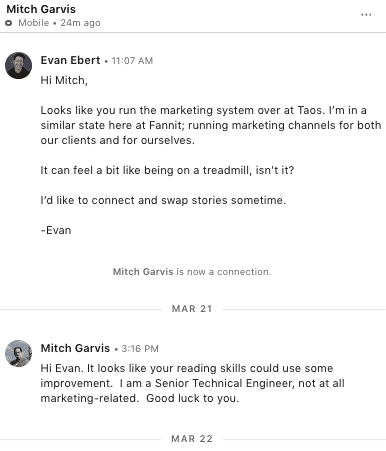
Okay, fair enough. Although I tried to restrict my LinkedIn search criteria for marketing folks, it seems LinkedIn made an error blip; surprise surprise.
People like Mitch with the title, “Senior Technical Engineer” don’t usually have anything to do with marketing. And it’s likely that I really pestered him with my outreach that could have been prevented if I had simply read his profile.
But before I could get am apology response over, Mitch came back with something else!
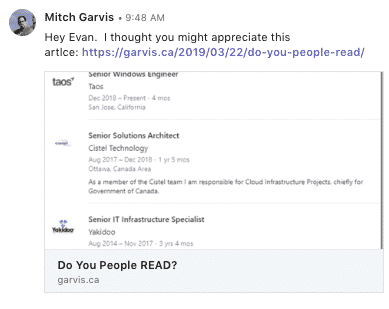
Yikes. Mitch had written a blog just for me. Let me help you understand exactly what this is.
This is a personal blog post by Mitch Garvis unpacking how inconsiderate my communication was, and disrespectful to him that I would not even take the time to personally look at his profile.
My communication was so far off the mark that it was ridiculous and made me look like a goofball.
But the real trouble is that the LinkedIn automation ran unhinged, and I allowed that to happen.
If I had taken a personal approach in connecting with Mitch, I would have seen that he wasn’t in my “target” audience as a marketing leader.
Although, to play devil’s advocate… if it weren’t for the automation, we wouldn’t even be connected PERIOD! 🙂
Ego: Target destroyed
When I started reading Mitch’s blog post, I felt pretty ashamed actually.
It was a sting of my ego being jabbed, and also an uncommon moment where some very transparent feedback came through the anonymity of the internet and spoke to me personally.
Most of the time, we simply don’t think about who is reading what we say, how the audience will REALLY react, and we just get too caught up in the numbers.
“Look, I made 93 new connections!”
But what good is that if they’re not REAL connections?
It’s like on Facebook — I don’t think any of us would profess to truly have 900 “friends” in real life. Dang, I probably have like 12 “good” friends myself, and even THAT is probably an exaggeration!
The Response
So after letting this simmer for a moment, I knew that I had a rare opportunity to make things right with Mitch.
I genuinely felt bad about the interaction, and felt like the best way to proceed was to lift the veil and tell him the truth. Tell him how this interaction even came about in the first place.
I sent Mitch a video response powered by Vidyard’s GoVideo tool… and basically “reacted” to reading his blog, apologized for my error, and explained why we did what we did.
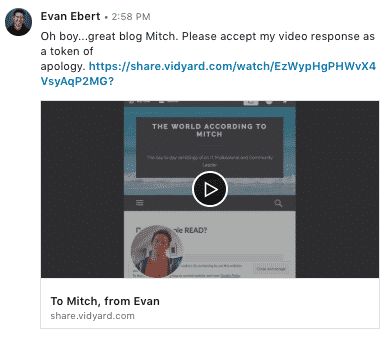
I also explained that the Fannit team is just full of people trying to figure all of this out too! And we really never meant to hurt anybody or be a nuisance.
There’s so much new tech, it’s hard to know how to wield it responsibly, especially when your competitors are not.
Well, it turns out that this response was very well-received! In my act of bringing the humanity back into the reaction, I was able to meet Mitch at a mutual line of communication that transcended social networks.
“Wait, what?”
Let me try again, less verbose.
Because I was so honest with Mitch about what was going on, and offered up a sincere apology and explanation, I was able to humanize Fannit, myself, and most importantly MITCH — the human on the other end of the interaction all along.
The response
Mitch definitely could have let me go here and say something like, “What a mook.”
But to my surprise, he came back with THIS as a response.
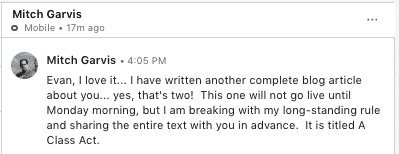
And here’s the twist… this time, the blog was a much more positive sentiment that paid tribute to the interaction, and the personal touch in our communication together.
Through simply telling Mitch the truth and treating him like the human being he is, we were both able to turn a negative interaction into a positive one that would live on!
Here is the blog, titled “A Class Act.” I highly recommend reading it! Mitch’s writing style is very free-flowing and fun to read.
My reaction to this new blog
Of course, I never expected to receive much of a response after my video… I considered the fault to be my own, and figured (based on history) that Mitch would probably just carry on and (maybe) block me 🙂
So seeing this was a wonderful moment! My response below:
 So now what?
So now what?
Mitch and I had a back and forth message conversation, and actually connected by phone some time later to discuss the situation and just get to know each other a bit.
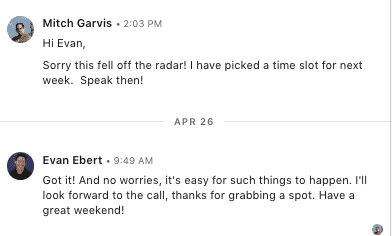
He definitely isn’t a marketer — but his accomplishments could be piled up all the way to the moon.
Mitch had amazing insights into the long line of tech developments that have led our society to where we are now. He’s been an active technical expert since the Internet was in its infancy.
Watching this entire process from inception sounded fascinating!
He is also very well-traveled, having lived in every possible time zone around the globe during his career. I don’t know anybody else that can say that.
Now, Mitch mainly works as an educator and mentor, passing his experience along to new folks looking to become experts like him and leave their mark on the world.
Consider your reality CHECKED
I wanted to share this experience with you because it was a special opportunity for me to really break “digital character” and get to know somebody as a human.
We get caught up in our marketing tactics and generating “leads” that it can be easy to forget that each person you connect with has a unique trail of experiences that led them there.
In fact, LinkedIn Lead Generation is but ONE tactic that should be part of a whole marketing strategy.
If you need to put together a more well-rounded strategy, definitely review our Ultimate Marketing Plan Guide.
Paying respect to that trail of experiences and treating it with the humanity it deserves will always beat automation that only speaks to people as a category…
However, there is a delicate balance. It is possible to use automated tools and still speak to the human at the other end, even if it takes an extra 1 minute on your part. This is what Fannit aims to do with our LinkedIn lead generation.
And when there is another human being with a lifetime of experiences on the other end… that extra minute is worth it.
LinkedIn Lead Generation Lessons
That’s a wrap though! This is a blog post that was not meant to be about educating you on SEO, PPC, and the like… but to just remind you that we are humans here too, having human experiences.
And every so often when that happens, it’s impactful enough to share.
My experience with Mitch was a good transformative experience. And I’m truly flattered to have been featured in not one, but TWO posts on his blog! So it’s only fair that we highlight him and his expertise here at Fannit!
Thanks for the great story that I get to carry with me, Mitch! And I’m sure we’ll be keeping in touch.
-Evan
Start Collecting LinkedIn Leads Today
Said in plain English, LinkedIn is a great place to collect B2B leads. Companies across the world use this platform to connect with other organizations. Some businesses even use it to find new providers and end up building lasting relationships that greatly benefit each other.
To learn more about the use of LinkedIn for lead generation, contact Fannit today. Our team will be glad to have a talk about scaling your company.
Recommended Article: B2B Digital Marketing
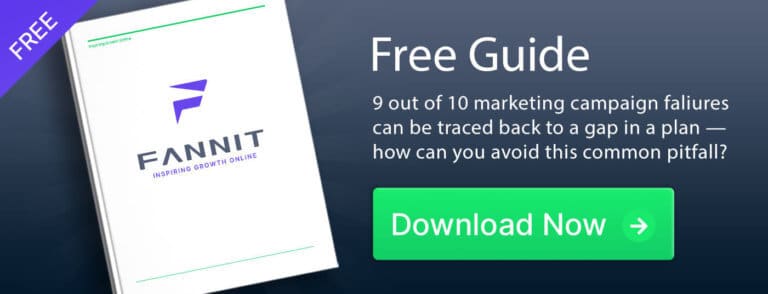
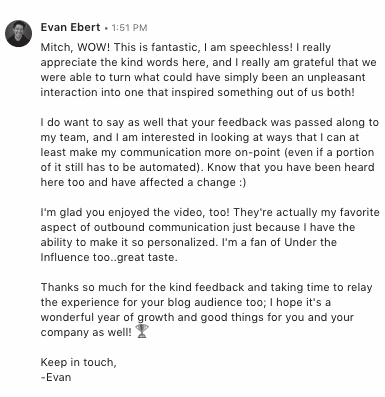 So now what?
So now what?